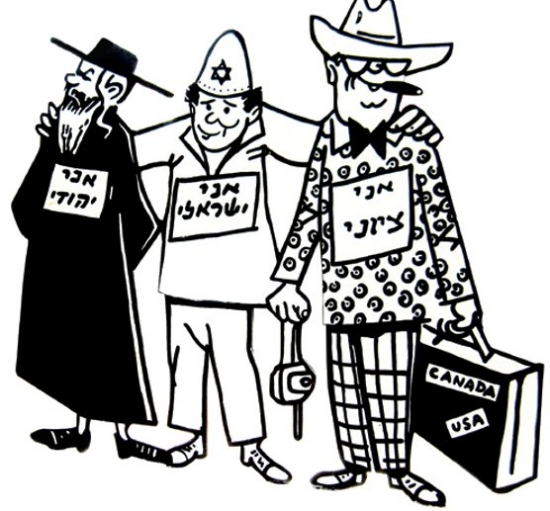
Taking a walk in the park: the signs telling one they are (from left to right) a Jew, an Israeli and the North American tourist whose sign reads “I am a Zionist,” and the loveable 'kova tembel' and sandal clad Srulik, created by Dosh (Kariel Gardosh). Photo from the Museum of Caricature and Comics, Holon
Holon is a city that today no longer lives up to its name - 'hol' (sand in English) other than that which is embedded in all the concrete of course.
The dunes of yesteryear have been gobbled up by building contractors and the few that remain seem to be covered in bulldozers leveling out the land for more housing projects.
A modern city with exemplary town planning and excitingly adventurous architecture, Holon boasts a large number of attractive parks and quiet landscaped corners as well as extraordinary museums attracting visitors from all over Israel. In latter years Holon has also become a fixture on the itinerary of overseas tourists, lured by the iconic Design Museum, Israel Puppet Center, Israel Children’s Museum, a Museum of Caricature and Comics and innovative parks with sculptures portraying well-known books for children. And, there is more.
After a hiatus of over 30 years, I recently visited Holon and left full of admiration for the 70 year old city that gives the impression that most of it was born yesterday. I left the city with a longer list of things to do in the town than I could accomplish in the time I had and so am already organizing the return visit.
Humor is serious business in Holon as proven by a visit to the Museum of Caricature and Comics opened last year on the second floor of a former school. Walking through the expansive courtyard toward the building, the visitor is greeted with black and white cut-out characters from the world of Israeli cartoons. Whether one recognizes them is immaterial because everybody coming toward the building is smiling broadly at the welcoming stationary committee on the lawn.
There are a number of permanent exhibitions in the museum, the first being the history of the art form known as caricatures. This exhibition takes one from the writing, or rather drawing, on the walls of Pompeii through to Leonardo da Vinci sketches and what one sees in the written and print media in modern times.
Another permanent exhibition is that telling a story through illustrated pictures or comics. In recent years three young Israeli artists who created a company called The Missing Link have had enormous success with the antics of a duck. A large two-page storyboard introduces one to their characters, and sketches have been drawn directly by the artists on the museum wall - one a self-portrait of the threesome as they figure out the next adventure of their Israeli-born characters – the table in front of them full of empty coffee cups!
Six of Israel’s pioneering illustrators and cartoonists are featured in a permanent exhibition of original sketches, characters and styles so familiar to at least two generations of Israeli newspaper and magazine readers. The ability to laugh, poke fun at and satirically criticize the state, its politicians and the Israeli in the street, has one in stitches – tears easily flow but not sure if from laughing or crying at those few strokes of a pen that hit so hard at one’s memories, sensitivities and here and there, shattering dreams one had in days gone by.
On the day I visited the museum I was fortunate enough to meet up with and see in action one of their contemporaries, 84 year-old Peretz Weinreich. A Polish born Holocaust survivor, Peretz has had over 22,000 of his illustrations and cartoons published in Israeli and overseas newspapers and journals. In a 45 minute workshop the sprightly octogenarian showed an amazing quickness of hand and mind as he dashed off some of his favorite Israeli and world political figures – from front and behind – teasing his audience to see if they knew who they were and quipping that “sometimes it is better not to look them in the eye!”
Peretz Weinreich only briefly mentions the Holocaust commenting that he ran away from Poland to escape the Nazis and ended up working in a forced labor camp in Russia for three years. He was eventually released when the Germans entered that country.
“I ran away because of the Nazis and was released because of the Nazis,” he says very quietly. He has brought examples of his past work, one of which depicts a small boy trapped under a steel SS helmet, 1940 – 1944 is written in the corner. The other half of the page, 1945 marked in the top corner, shows the same small child, fingers giving the V sign, Magen David on an armband, sitting with his trousers down on an upturned steel SS helmet, using same for his excretions
Peretz also spent time in a British Mandate detention camp in Cyprus before finally making his way to Israel.
“I don’t want to talk about that period of time now. You have come to the museum to concentrate on the creation of caricatures, cartoons and comics,” he says whilst quickly filling another of the pages on the clipboard stand in the room.
By the end of the workshop, the artist’s adult audience was spellbound by his talent, energy, humor and range of capabilities in putting into a quickly fashioned illustration what takes a writer hundreds of words.
As the workshop drew to a close and with folks clamoring to be able to take one of the pages home, a young lady from the museum stepped in and sternly announced that all the sketches would go immediately into the museum archives on the ground floor.
We had all forgotten we were in a museum!
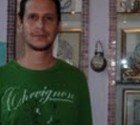 AMIT DRESSLER - HELPING THE LESS FORTUNATE
AMIT DRESSLER - HELPING THE LESS FORTUNATE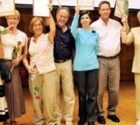 ESRA VOLUNTEER AWARD WINNERS 2010
ESRA VOLUNTEER AWARD WINNERS 2010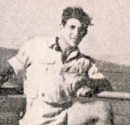 FACT OVERWHELMS FICTION
FACT OVERWHELMS FICTION Art from the Heart
Art from the Heart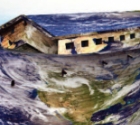 Jewish Art Returns to Jerusalem
Jewish Art Returns to Jerusalem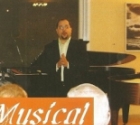 Musical Treats
Musical Treats Lydia Aisenberg
Lydia Aisenberg